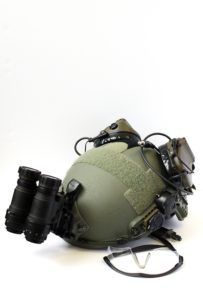
This is going to be a series of posts about head mounted equipment for SWAT teams. I am going to talk a little more about concepts and less about specific brands.
I am also going to answer some of the questions you may have if you are making a purchase for your team or yourself.
The Ballistic Helmet: A Comfortable Foundation
Don’t underestimate the importance of comfort in a ballistic helmet.
In a previous post on gear selection I talked about the importance of comfort. The helmet is the literal foundation of all of your head-borne equipment, so it is really important you don’t dread wearing it.
It is important to note that at some point, every ballistic helmet becomes uncomfortable to wear. You want to reach the point of discomfort in hours not 10 minutes.
So, when it comes to selecting a ballistic helmet, comfort is especially important.
Test and Evaluation
After settling on a few potential helmets, setup a test and evaluation period. I recommend this process for any high dollar purchase your agency is going to make for your team.
If you select one of the more high-end helmet brands, your agency is about to drop $900-$1000 per helmet, so you do not want to screw the selection process up.
During the evaluation make sure more than just one person tries out the proposed helmet or helmets. Make sure when people wear the helmet it is for as long as possible. If they can wear it for a few hours during training that is great.
If not, a few hours around the house will have do.
If you are making a personal purchase, find a way to try the helmet on before you buy it. It is worth the effort, unless you like helmet induced headaches.
Helmet Sizing
Don’t forget, you have to size the head of every team member who will be wearing a helmet. A medium/large Ops-Core Fast helmet will definitely not fit someone that needs a large/X-large.
If anyone on the team regularly wears a balaclava during operations, I would recommend they do the sizing with the balaclava on, because it can make a difference.
Quick Points on Helmet Accessories and Options:
- Select a helmet comes with a rail system and/or pre-cut Velcro. It will make mounting equipment much easier.
- Strongly consider a helmet that is either pre-drilled for a night vision mount or already has the mount installed (more on mounts in a later post). Even if your agency is not considering night vision right now, you want to have the option to add it without another expense.
- If your team already has night vision or other helmet mounted equipment make sure those items are still compatible/usable on the new helmet.
- Purchase a chin strap extensions if your operations require gas masks. Normally when you don a mask and buckle the helmet’s chin strap, the strap chokes you or you don’t buckle your chin strap. The extension will let you buckle the chin strip properly and comfortably.
Chin Strap Mod
Ops-Core makes chin straps that are compatible with MICH helmets. They have a more comfortable geometry, easier to adjust, and are designed to better support helmet mounted night vision.
While the strap is more expensive now than when I bought it, it is infinitely more comfortable than a stock MICH style chin strap.
Ballistic Rating
If your department has a policy that covers ballistic equipment other than soft body armor make sure you are familiar with it.
If you have a choice, I would get a helmet with a higher ballistic rating than one that has a lower rating.
Do your homework before you buy.
If you need more information on ballistic ratings you can find it here at the NIJ.
Remember
A lot of equipment can find its way onto your helmet, especially if your team conducts operations at night. Just like the rest of your equipment, keep what you wear on your helmet strictly to the essential.
Mounting only essential equipment will save you serious head (and neck) pain.
Wrap Up
That covers ballistic helmets in the broad strokes. The big take away from this post is whatever helmet you select is probably going to be with your team for a while. Take the time to find out what the best long term choice is for your team.
Up next in part 2 of this series I will be covering hearing protection/communication systems.
